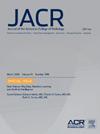介入放射学住院医师项目的多样性。
IF 5.1
3区 医学
Q1 RADIOLOGY, NUCLEAR MEDICINE & MEDICAL IMAGING
引用次数: 0
摘要
目的:评估综合介入放射学(IR)住院医师项目的多样性。方法:从2018年到2023年,研究人员查阅了美国医学院年度住院医师报告(观察性横断面研究),以提取各种住院医师项目(包括综合IR)的人口统计信息(性别、种族和医学院类型)。使用卡方检验比较不同专科的人口统计数据,显著性水平为p。结果:2023年,综合IR在评估的21个专科中分别排名第20、第21和第19位,以代表女性、黑人和西班牙裔居民。女性的比例从2018-19学年的20%增加到2022-23学年的22.3%。黑人居民的比例从2019-20年的2.2%上升到2022-23年的3.8%,而西班牙裔居民的比例从7.1%下降到6.6%。此外,美国印第安人和阿拉斯加原住民的比例从0.8%下降到0.7%,而夏威夷原住民和太平洋岛民的比例从0%上升到0.1%。讨论:综合IR住院医师的多样性是医学专业中最低的之一,并且进展最小。共同努力提高对该专业的认识和包容性,将扩大其吸引力,并可能最终改善其供应情况。本文章由计算机程序翻译,如有差异,请以英文原文为准。
Diversity in Interventional Radiology Residency Programs
Purpose
The aim of this study was to assess diversity within integrated interventional radiology (IR) residency programs.
Methods
The annual Association of American Medical Colleges Report on Residents, an observational cross-sectional study, was accessed from 2018 through 2023 to extract demographic information (gender, race, and type of medical school) on the various residency programs, including integrated IR. Demographic data were compared among different specialties using the χ2 test, with a significance level of P < .05.
Results
In 2023, integrated IR ranked 20th, 21st, and 19th out of the 21 specialties assessed for the representation of women, black, and Hispanic residents, respectively. The proportion of women increased from 20% in academic year (AY) 2018-2019 to 22.3% in AY 2022-2023. The percentage of black residents increased from 2.2% in AY 2019-2020 to 3.8% in AY 2022-2023, whereas that of Hispanics decreased from 7.1% to 6.6%. Additionally, the percentage of American Indians and Alaska Natives decreased from 0.8% to 0.7%, whereas that of Native Hawaiians and Pacific Islanders increased from 0% to 0.1%.
Conclusions
Diversity in integrated IR residency is one of the lowest among the medical specialties and has progressed minimally. A concerted effort to increase awareness and inclusion in the specialty would broaden its appeal and may eventually improve its availability.
求助全文
通过发布文献求助,成功后即可免费获取论文全文。
去求助
来源期刊

Journal of the American College of Radiology
RADIOLOGY, NUCLEAR MEDICINE & MEDICAL IMAGING-
CiteScore
6.30
自引率
8.90%
发文量
312
审稿时长
34 days
期刊介绍:
The official journal of the American College of Radiology, JACR informs its readers of timely, pertinent, and important topics affecting the practice of diagnostic radiologists, interventional radiologists, medical physicists, and radiation oncologists. In so doing, JACR improves their practices and helps optimize their role in the health care system. By providing a forum for informative, well-written articles on health policy, clinical practice, practice management, data science, and education, JACR engages readers in a dialogue that ultimately benefits patient care.
 求助内容:
求助内容: 应助结果提醒方式:
应助结果提醒方式:


